Notes From the Mountaintop
You can't live your life on the mountaintop, but you can enjoy the experience!
It’s 10:30 PM, April 17th, and we are driving from Portland, Oregon to Mount Hood on our way to attempt a summit climb of Oregon’s tallest (and most dangerous) peak. Packed in the truck is me, two old college friends, and our guide. We’ve been training for this moment for the last two months, perhaps even years if you include the other mountains we’ve climbed in past summers. We arrive to Timberline Lodge at midnight—the parking lot lined with other climbers sleeping in their vehicles against the snowbank. Some already getting gear on beneath the glow of red headlamps. There is no light from the sun or moon, not yet, but we have a lucky weather window: The skies are clear with only a small chance of wind. After getting our backpacks and gear arranged, we set off in the black night, up and up the snow.
For most of my life I’ve sought mountaintop experiences. Both literally and figuratively. I grew up in the mountains of Colorado, spent my youth hiking “14’ers” (mountains 14,000 feet tall), rock climbing, and snowboarding. When I moved to the Pacific Northwest, I set my sight on the climbing several of the “Cascade Giants,” all of which are glaciated volcanoes. After summiting Mount Adams and making it ¾ of the way to Mount St. Helens, I learned the required mountaineering skills required for glacier travel—which includes knowing how to arrest a fall with an ice axe and using crampons—and I finally felt ready to tackle Hood. My old college roommates had always wanted to climb the local mountain we saw every day from our homes. So as my one friend approached his fortieth birthday, he decided to get serious about a summit attempt. Our other friend found us a guide from his church who had extensive experience on Hood. Despite being the 2nd most climbed mountain the world, it can still be quite dangerous if you don’t know what you’re doing. People still die every year.
Headlamps on, we march up the crunchy white snow to the right of the Timberline ski slope. The still silhouette of the mountain before us lies underneath a thick black sky full of stars. In seven or eight hours, we will hopefully be at the top. But that seems a long way away and I’m not sure how my energy is going to be pulling an all-nighter. Not since college have I attempted such a feat. A mix of adrenaline and a yerba matte energy drink courses through my blood stream. I’m breathing heavy on the uphill, not quite as fast as the others, but my lungs and legs feel strong. I know I can do this, I think, but will my mind betray me somewhere along the way? Will I give in to some excuse? Will I become paralyzed at the top for fear of falling, visions of my two daughters growing up without a father screaming through my brain? It’s only 7 miles round trip, but with 5,000 feet of elevation gain.


As we ascend, we can see the city lights of Portland and Madras less than a hundred miles away twinkle in the night. A pink moon rises around three in the morning. By four we are at the top of the Palmer glacier and Palmer chairlift. Mountaineering might seem like a lot of excitement but 90% of it is hiking very slowly up a hill in the snow. Yet if we thought hiking up a ski slope was tough, the grade only gets steeper from here. Crampons are now required. Another 1,500 feet of elevation puts us beside Crater Rock, where the smell of Sulphur overwhelms our senses. As Mount Hood is an active volcano there are literally vents—fumaroles—of hot Sulphur breathing and steaming out of the mountain. Here we take a break for some food and water. I snack on an energy Stroop waffle and pop a flavored chewy block with 25 mg of caffeine.
“Remember to enjoy it,” our guide says, trying to keep us from thinking of how hard the climb is, but also, that this, right here, is a special experience to take in.
For most of my life I’ve been in search of a elusive “meaning to life”, one that could be explained through religion or philosophy or even science. I’m always wondering why? Why life? What’s the point of it? So I read and read and read. (Man’s Search for Meaning perhaps being my favorite) And then one day I realized the meaning of life was right there in front of me, in all those small, tiny moments of just simply being present, mostly with my two daughters. I try to remember that this right here, this huffing and puffing, this throb in my right foot, will soon be a minor footnote in an epic chapter.
A crevasse opening in the snow above us has most people cutting left through the hot rocks (literally an area of hot steaming rocks on which snow always melts) and then up to the summit chutes, rather than climbing straight up the ridge of the Hogsback and then left. We put our harnesses on and trade our trekking poles for ice axes. Now is the fun/scary part. The final 1,000 feet of the ascent.
The south side of Hood is a Grade II, Class III Glacier climb which basically means around half a day of technical climbing is required and also steep climbing with sustained technical climbing mixed in—In this case a grade of around 60%? at the top, which means you’re on all four with two ice axes at the top, crawling basically, while plunging your ax in and kicking steps with your crampons. Sound like fun? Cause it’s rockin! Totally metal. I felt like I was practically vertical (particularly on the down climb) even when it was far from it.
Finally, around 7:30 a.m. we reach it, the summit. The mountaintop. We can see Mount Rainier, Mount Adams, and Mount St. Helens in a triangle to the North. South Sister and Mt. Jefferson to the south. The Columbia River stretches far east into the Eastern Oregon plains. If it wasn’t for the Coast range to the West, we might even be able to see the Pacific Ocean. We eat some more food, drink some more water, take a picture, and soon begin our descent.
You can’t live your life on the mountaintop as the saying goes. For the mountaintop is an exhilarating but brief experience. Also, it’s not the most comfortable or safe place. It’s windier and colder, good for views, but not for camping.
I’m still feeling the high from summiting Mount Hood a few weeks ago, and yet I’m already worried about how I’m going to feel when things drop back to reality. What will I have to look forward to? Will I snap back to my old grumpy, exasperated self? My same vices and overconsumption of foods and beverages? Probably. The key is balance. The key, I’m realizing, is learning how to survive the valleys, enjoy the plains, not give yourself a hard time on those off days, and enjoy those mountain tops when you get them. An adventure wouldn’t be an adventure without some discomfort along the way.









